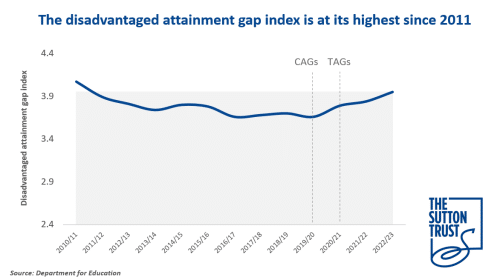Press Releases
Commenting on data on Key Stage 4 performance released today, Sir Peter Lampl, founder and Chairman of the Sutton Trust and Chairman of the Education Endowment Foundation, said:
“It is concerning that the attainment gap between disadvantaged pupils and their peers has widened again this year. The gap is now at its highest level since 2011, meaning a lost decade for improving the life chances of low-income young people.
“The disruption young people have faced through the pandemic, the cost-of-living crisis and persistent absence from school has severely hindered their learning and we are seeing the impact in these results. Unless we take decisive action particularly on persistent absence from school this will put a brake on social mobility for a whole generation.”
NOTES TO EDITORS
- Overall GCSE grades are down once again this year, with the planned return to the level of grades in 2019.
- 45% of pupils achieved grade 5 or above in English and maths GCSEs in 2023, down 4.8 percentage points since 2022, but still higher than the 43.2% who did so in 2019 before the pandemic.
- Average Attainment 8 score (grades across a pupil’s best 8 subjects including English and maths) decreased from 48.8 in 2022 to 46.2 this year, still lower than 46.7 pre-pandemic.
- Most concerningly, the attainment gap between disadvantaged pupils (those eligible for Pupil Premium funding) and their classmates has continued to widen. The ‘disadvantage gap index’ is now up to 3.95, up from 3.84 in 2022 and 3.7 in 2019. The gap is now at its highest level since 2011, eroding any progress made in the last decade.
- In terms of Attainment 8, the gap has also widened slightly, from 15.2 points in 2022 to 15.3 points this year, and up substantially from 13.6 points in 2019. This represents a widening of 13% since before the pandemic.
